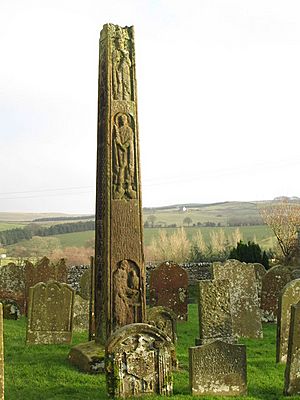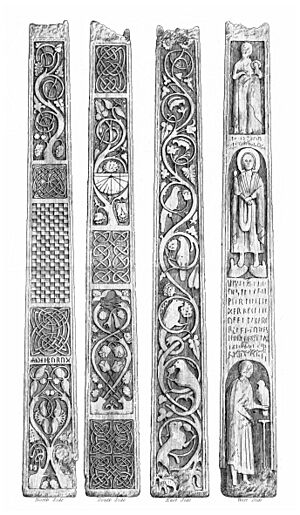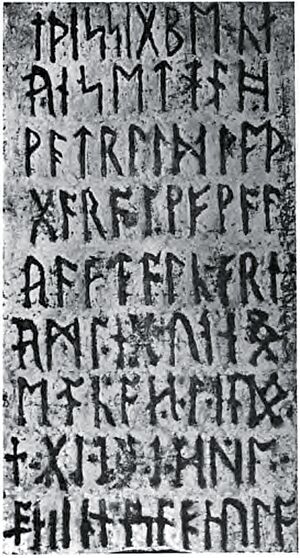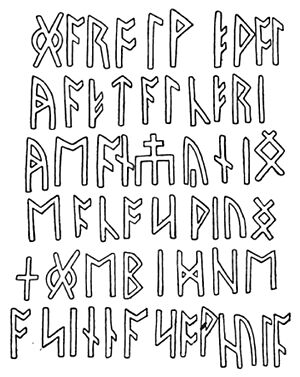Bewcastle Cross facts for kids
The Bewcastle Cross is a very old stone cross from the Anglo-Saxon period. It stands in its original spot in the churchyard of St Cuthbert's church in Bewcastle, Cumbria, England. This special cross was likely made in the 7th or early 8th century. It has cool carvings called reliefs and messages written in the ancient runic alphabet. The top part of the cross is missing, but what's left is about 14.5 feet (4.4 metres) tall. It's almost square at its base, measuring about 22 x 21.25 inches (56 x 54 cm). Experts like Nikolaus Pevsner have called the Bewcastle Cross and the Ruthwell Cross "the greatest achievement of their time in all of Europe."
Contents
When Was the Bewcastle Cross Made?
The Bewcastle Cross is quite similar to another famous cross, the Ruthwell Cross. Both are large and beautifully decorated. They are among the best Anglo-Saxon crosses that have survived mostly whole.
Historians still discuss the exact age of both crosses. However, many now agree they were likely made in the first half of the 8th century. This time is sometimes called the "Age of Bede," after the famous scholar who died in 735 AD.
Some people think the cross might have been built by a team of skilled stone workers. These workers might have been brought in by Benedict Biscop in the late 600s. They helped expand the Monkwearmouth-Jarrow Abbey, which was a major cultural center back then.
Amazing Carvings and Designs
Each of the four sides of the Bewcastle Cross is covered with detailed carvings. These carvings are split into different sections or panels. You can see figures (only on the west side), animals, checkerboard patterns, and twisting vine designs. There are also complicated interlace knots and even an old sundial. The north, west, and south sides of the cross also have runic inscriptions. The other three sides mostly show patterns of knots, vines, and checkerboards.
The west face is the one you see when you enter the churchyard. It has four panels. Two panels are arched, and two are square. Three of these panels show figures, while one has runes.
- At the top, a square panel shows John the Baptist. He is holding the Lamb of God and pointing to it.
- Below that is an arched panel. Here, a glowing Christ is shown standing on the heads of two creatures. He is raising his right hand to give a blessing and holding a scroll in his left. This carving shows Christ as a judge, recognized by the animals. Some think it shows Christ defeating evil, but a similar carving on the Ruthwell Cross explains it as Christ the judge being recognized by desert beasts.
- Between the top two panels, a runic message reads "+GESSUS KRISTTUS" (Jesus Christ).
- Below the arched panel of Christ is a square panel with more runic writing.
- At the very bottom of the west face, there's an arched panel with a figure holding a falcon. This figure might be St. John the Evangelist with his eagle.
The sundial on the cross is the oldest English sundial still existing. It's divided into four "tides," which were like work periods in medieval times.
Mysterious Runic Messages
Many of the runic inscriptions on the cross are hard to read because of weather damage. Scholars have tried to figure out what they say.
- On the north face, between the first and second panels from the bottom, the name Cynnburug can be clearly seen. Cyneburh was a common name, so it's not certain if it refers to the wife of King Aldfrith.
- The north side might also have runes above the fifth panel that are very faint. They might mention Wulfere, who was a king of Mercia.
The main runic inscription is on the west face, as the second panel from the bottom. Only a few words are clear. One interpretation suggests it says: "This slender pillar Hwætred, Wæthgar, and Alwfwold set up in memory of Alcfrith, a king and son of Oswiu. Pray for their sins, their souls".
This might be talking about Egfrid, who became king in 670 AD. He was the son of Oswy and brother of Alhfrith.
A Copy of the Cross
You can find a copy of the Bewcastle Cross in the churchyard of St Mary's Church near Carlisle. This copy even tries to show what the missing top part of the original cross might have looked like. However, the copy looks a bit different in style and details compared to the real one.
Gallery












